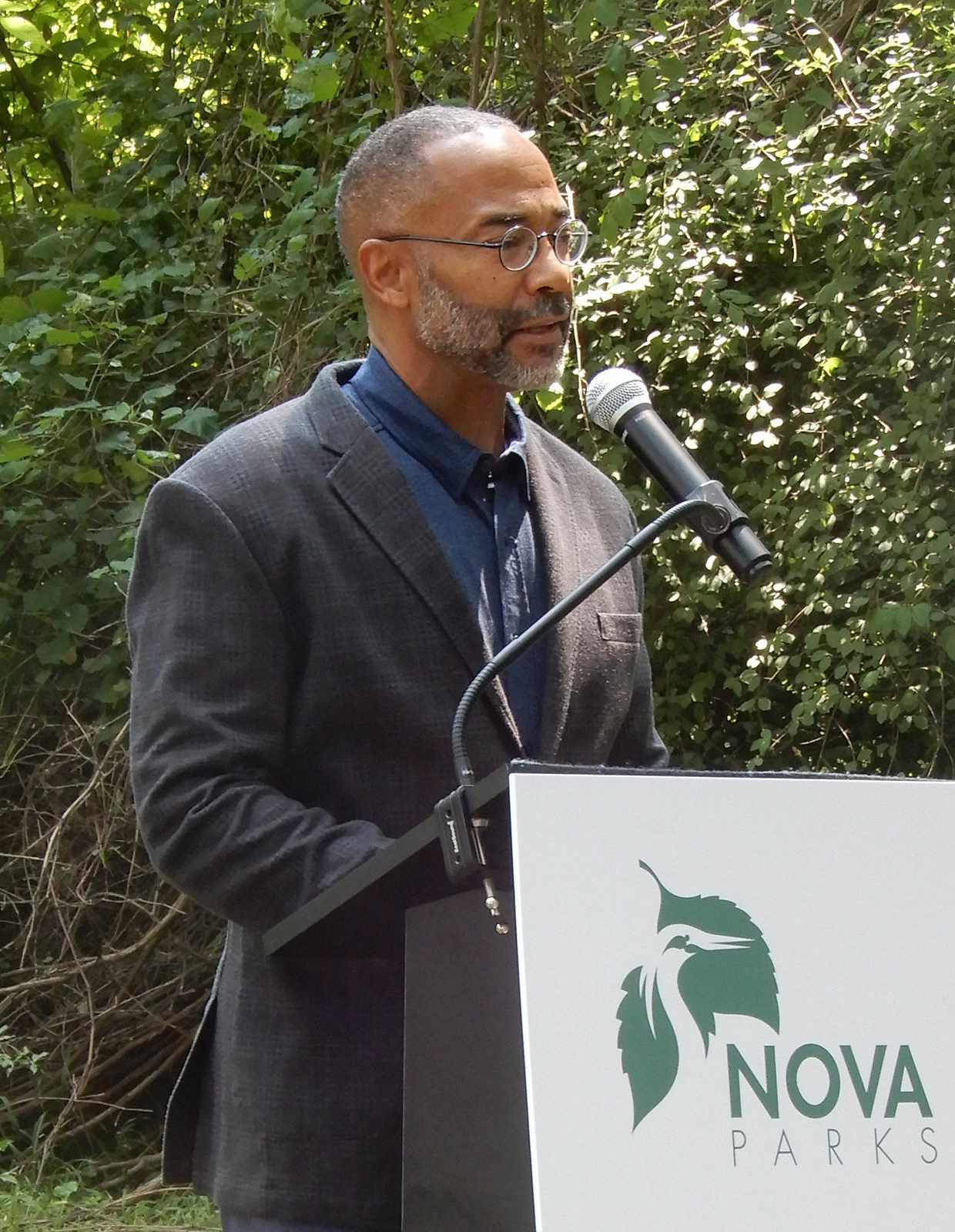Candice McKinney, left, and Winter Harris sing “Amazing Grace.” Photo by Bonnie Hobbs.

Bonnie Hobbs/The Connection
Bishop Brett Fuller shares his story.
Standing on the site where the historic Bull Run Baptist Church once stood in what’s now Centreville’s Bull Run Regional Park, Bishop Brett Fuller shared his own story with those attending a Juneteenth ceremony there on June 17. First, though, he marveled at what an accomplishment that church was for its time.
“This wasn’t just a radical church – it was dangerous,” he said. “Blacks and whites worshiping together in 1775, and it made some other states want to do it, too.”
As the founder of Grace Covenant Church in Chantilly – and chaplain to the Washington Commanders football team – Fuller, a Black man, is well-known in the area and well-liked by people of many races. But it wasn’t always that way.
“Today, Blacks and whites go to school together, work together, ride the same buses and shop at the same stores – and nobody says anything because it’s not segregated anymore,” he said. “But I don’t take it for granted because I remember what it was like growing up in Kansas City.”
Fuller’s family moved to the suburbs in 1966, when he was 5. “The ‘hood’ wasn’t the safest place for us, but I was wondering, ‘Did you think the white suburbs were supposed to be safer?’” he recalled. “But I was a kid, too young to articulate that. I went to a school to which no Black kid had ever been – we broke the color barrier in our neighborhood.”
In response, said Fuller, “They egged our house. One day, my daddy brought home a beautiful, 1964, cherry-orange, ragtop Mustang. He came outside, and somebody had destroyed it – took a knife to the top, a sledgehammer to the hood, ripped the tires, pulled out the seats. It was terrible.”
Meanwhile, at school, “I got called every name in the book,” said Fuller. “They knew my first one – they just didn’t use it. My parents were so conciliatory. They said, ‘Baby, it’ll be all right; you just forgive and love.’ As a result, they created some children – my sister, brother and me – who understood something about what reconciliation looked like.”
Fast forward to 1982, when he was going into the clergy, with all the lessons of his childhood informing his intentions. “I said, ‘Lord, if You give me the privilege of ever pastoring a church, I don’t want it to look like me,’” said Fuller. “I didn’t know Robert Carter III [see Juneteenth story] existed, but I realize I inherited his vision and courage.
“Today, we’ve got a congregation that has some Black folks, but we’ve attracted all kinds of people – including as my staff. I’ve just passed on my church to the younger generation, which has grown it even more. I’ve been in ministry for 42 years, and God has given me my dream. And what’s most important in my church is unity.”
Outside the church, Fuller said people still need to address diversity, equity and inclusion and how to obtain “fair justice for all. Inside the church, we understand what it means to deal with difficulty in a way that doesn’t divide but unites.
“I’m not going to wear my bitterness, anger and resentment on my sleeve. I’m going to understand somebody else’s either ignorance or hurt and pain. And in doing so, I can be a conduit of healing to them – which allows them to feel unthreatened and to come in my direction.”
He said healing happens in his world because he doesn’t stop at justice but goes all the way to reconciliation.
“Justice only brings consequences to the offender,” he explained. “It doesn’t bring wholeness to those offended – reconciliation does. It means past injustices are forgiven, and we ask, ‘How can we work this thing out and walk together?’”
Basically, said Fuller, “It’s an extension of what Carter did. So, to the Harris family and everybody related, I’m grateful for this hallowed ground. It’s not just a place where we memorialize people who passed. There’s a living legacy that springs from the dirt, up through the trees.
“When you do the archaeology and make these [church] foundations visible, I’d love to mark them by people standing all around and then have a prayer meeting here. Because the church is beyond just borders of brick and mortar – it’s people.”
Fuller also eventually wants to see a memorial in Fairfax County and in Virginia recognizing “the enormous contributions” made here and throughout the commonwealth by the former slaves buried in this church’s cemetery. And he explained why it’s so important to do so.
“We almost want to act like these people didn’t exist,” he said. “We took away their identities when they came from Africa and gave them American identities. They were named after their slave masters – wiping away all their history – and we’re still trying to do that.”
So within the next 20 years, said Fuller, “I not only want to see congregations established in the manner in which Carter established his, but I’d like to see something on the National Mall and in Virginia that represents honorably the sacrifices, sweat and tears that came from those of African descent that helped build this state and country. May God help us through that.”
